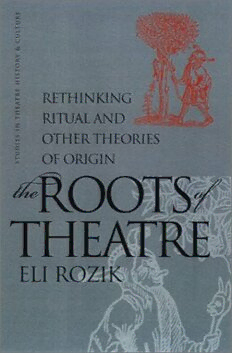
The Roots of Theatre: Rethinking Ritual and Other Theories of Origin PDF
Preview The Roots of Theatre: Rethinking Ritual and Other Theories of Origin
the roots of (cid:1)(cid:2) theatre studies in theatre history & culture Edited by Thomas Postlewait the roots of th(cid:1)ea(cid:2)tre Rethinking Ritual and Other Theories of Origin Eli Rozik university of iowa press iowa city University of Iowa Press, Iowa City 52242 Copyright © 2002 by the University of Iowa Press All rights reserved Printed in the United States of America Design by Richard Hendel http://www.uiowa.edu/~uipress No part of this book may be reproduced or used in any form or by any means without permission in writing from the publisher. All reasonable steps have been taken to contact copyright holders of material used in this book. The publisher would be pleased to make suitable arrangements with any whom it has not been possible to reach. Printed on acid-free paper Library of Congress Cataloging-in-Publication Data Rozik, Eli. The roots of theatre: rethinking ritual and other theories of origin/ by Eli Rozik. p. cm.—(Studies in theatre history and culture) Includes bibliographical references and index. isbn0-87745-817-0 (cloth) 1. Theater—Origin. 2. Rites and ceremonies. I. Title. II. Series. pn2125.r69 2002 792(cid:1).01—dc21 2002018925 02 03 04 05 06 c 5 4 3 2 1 To my wife, Atara, my best friend co(cid:1)nt(cid:2)ents Introduction, ix part one. theories of origins 1. Basic Definitions, 3 2. The Ritual Origin of Tragedy, 29 3. The Ritual Origin of Comedy, 49 4. The Shamanistic Source, 69 5. The Recreation of Theatre by Christianity, 90 6. The Mummers’ Plays, 111 7. The Adoption of Theatre by Judaism, 129 8. Back to Aristotle, 140 part two. hedges and boundaries 9. Performance Theory, 165 10. The “Drama” of Real Life, 185 11. The Spirit of Carnival, 206 12. Culture as Play/Game, 226 part three. a theory of roots 13. The “Language” of Dreams, 247 14. Playing as Thinking, 270 15. Mythical Representation, 293 16. Retracing the Steps of History, 314 17. Reflections and Conclusions, 335 Bibliography, 349 Index, 357 intro(cid:1)d(cid:2)uction In this study I have set out to question a theory that has become a cultural com- monplace even beyond the circles of theatre scholars: that the origin of theatre lies in ritual. This commonplace reflects the impact of a unique approach to the- atre, particularly that of the School of Cambridge, which attempted to lend sci- entific foundations to earlier intuitions by applying a combination of histori- cal and anthropological methodology. Although already discredited for many years by the excellent scholar Arthur W. Pickard-Cambridge, the influence of the School of Cambridge remains clearly discernible in subsequent theories. Promi- nent scholars, despite their rejection of some of its methods, still explain the de- velopment of Western drama and theatre in terms of its supposed ritual origins. Moreover, under the influence of recent anthropology, which has expanded the notion of “ritual” beyond religious practices, some theatre scholars developed models that presuppose an even more fundamental relationship between ritual and theatre. The lasting influence of the theory of ritual origin is mainly reflected in text- books on the history of theatre. For example, in Phyllis Hartnoll’sA Concise His- tory of the Theatre(1971): “The origins of the theatre go back far into the past, to the religious rites of the earliest communities. Throughout the history of man- kind there can be found traces of songs and dances in honour of a god, per- formed by priests and worshippers dressed in animal skins, and of a portrayal of his birth, death, and resurrection” (7). In Jack Mitchley and Peter Spalding’sFive Thousand Years of Theatre (1982): “Theatre began in ritual. Ritual needed tech- nique to become effective. When the artist of theatre began to practice technique for its own sake, then the ritual became an art. When it became an art it kept the same mainspring that it had when its function was purely ritual. The mainspring is the costumed actor and his resources” (17). Oscar G. Brockett inThe Theatre (1991) acknowledges that the ritual-theatre relationship was reconsidered under the influence of recent anthropological research and that theatre was no longer seen “as necessarily originating in ritual; rather ritual and theatre were viewed as coexisting modes in which the same elements might be used for differing
